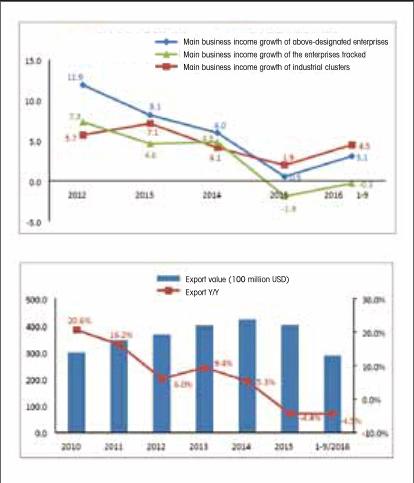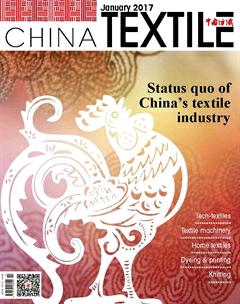Status quo of home textile industry(Jan.—Sep.,2016)
By+Zhao+Zihan

From January to September last year, the home textile industry saw somewhat increase in overall operation year on year, presenting tend-tobe-good benefits, sharply falling investment, steady growth in domestic sales, export value decrease, and slightly increase in the export volume.
Overall performance
During the first three quarters of 2016, according to the National Bureau of Statistics, 1,830 above-designated home textile enterprises enjoyed the main business income of 193.478 billion yuan with an increase of 3.06% year on year, 2.16 percentage points higher over the same period in 2015 and 2.52 percentage points higher than the year of 2015.
The industry has been enjoying continuously improved benefits since the beginning of 2016, and profit growth is still higher than the growth in sales revenue, while production efficiency has also been greatly improved thanks to promoted technological progress and management. During the 9 months last year, the industry saw a total profit of 11.110 billion yuan with an increase of 7.08% year on year, up 3.67 percentage points over the same period of the previous year, while the profit margin grew by 0.4 percentage point year on year to 5.74%. The statistics show that the 16 industrial clusters and 230 enterprises witnessed improved efficiency, while the per capita total industrial output value grew steadily.
The data from National Bureau of Statistics show that from January to September, 2016, the statistical home textile enterprises achieved investment of 50.884 billion yuan, down 11.71% over the same period of the previous year, and the growth rate declined by 33.18 percentage points. Industrial investment growth fell sharply, except that the towel product manufacturing investment increased by 3.7% year on year, the other sub-sectors saw year-on-year decline in varying degrees.
During the first 9 months last year, 1,830 above-designated enterprises achieved domestic output value of 150.594 billion yuan with a yearon-year growth of 3.83%, increasing by 2.14 percentage points, while the 16 industrial clusters saw an increase of 2.30% over the same period of the previous year.
Currently, the industry is in a new period of development with dif- ferences that strong enterprises are enjoying more advantages while the disadvantaged ones are suffering more difficulties. Among the 1,830 abovedesignated enterprises, the loss-making enterprises presented a year-on-year growth of 33.33% in the amount of loss while the profit-making ones enjoyed increasing total profit by 9.36%.
Export
According to the Customs, from January to September last year, Chinas home textile exports amounted to 28.614 billion USD, down 4.49% year on year. Specifically, exports to the United States and Europe accumulated to 14.594 billion USD, declining by 2.74% year on year; total exports to other markets were 14.02 billion USD, a year-on-year decrease of 6.24%.
During the first three quarters of last year, Chinas home textile exports increased by 2.66% year on year, while the export unit price fell by 6.96%. Among the eight categories of products, the export volume of six categories presented different degrees of growth, and the towel products rose up to 11.52% year on year. In contrast, the export prices of seven categories fell significantly, of which, blanket products fell by 9.98 percentage points year on year. The general falling export prices of major categories resulted in reduced export value. Since the beginning of last year, the growing higher exchange rate of RMB against USD has objectively affected the export price of Chinas home textile products.
During the 9 months last year, both traditional and emerging markets presented various degrees of decline in total exports, except a small steady growth in the EU and a slight recovery in ASEAN and Russia. Among them, the US market declined significantly, and the Japanese market continued to sluggish. The exports to the 17 Middle East countries presented more reduction while those to the three countries of South Asia became negative. However, the export volume to most major markets continued to increase year on year.
- China Textile的其它文章
- Dear readers
- Calendar
- Status quo of Tech—textile Industry in the first three quarters of 2016
- Status quo of China’s textile machinery industry(Q1— Q3,2016)
- The economic operation analysis of dyeing and printing industry(Jan.—Sept.,2016)
- Status quo of China’s knitting industry,Jan.—Oct.,2016

